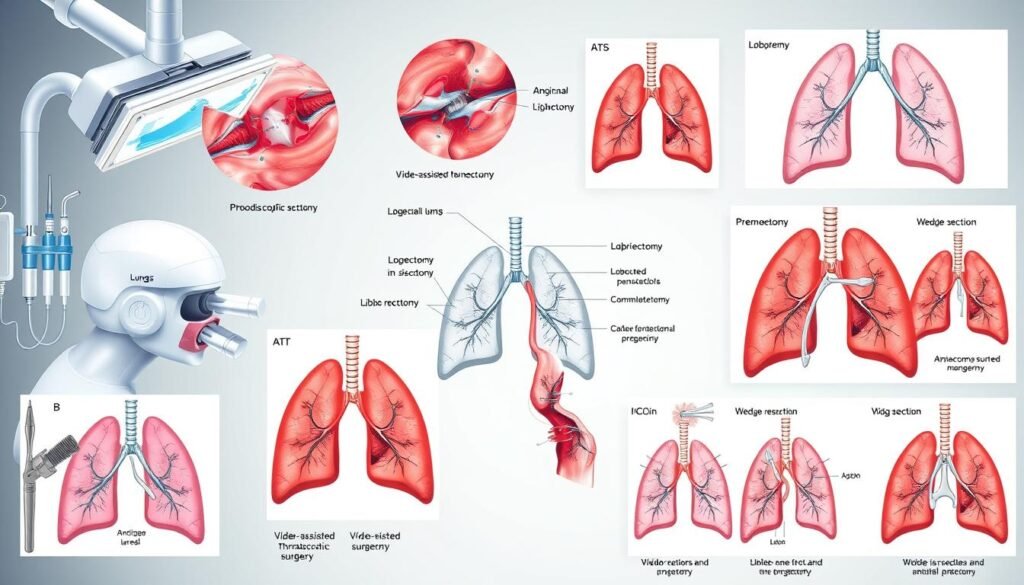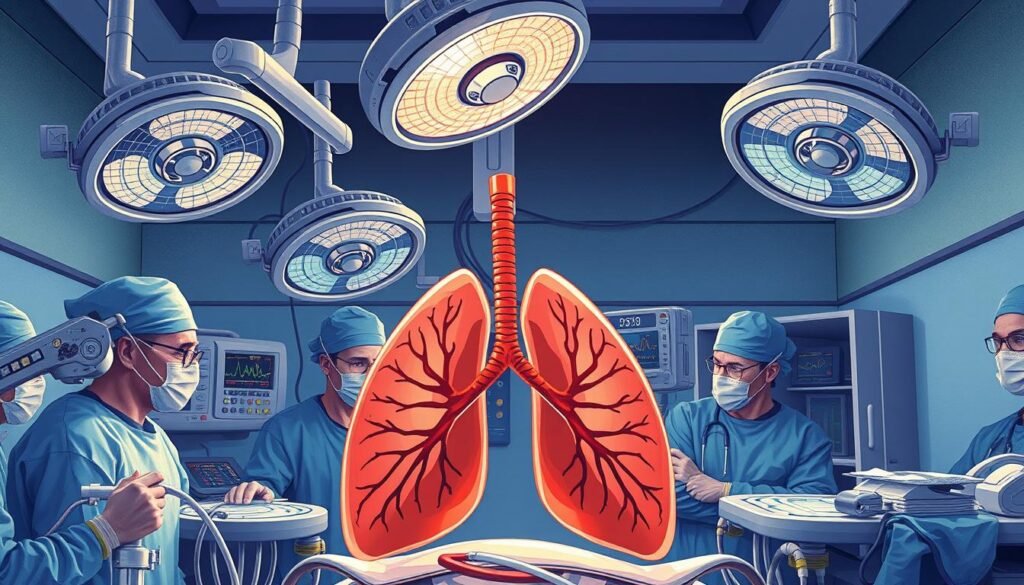About 60% of people with stage 0 non-small cell lung cancer (NSCLC) may be cured with just surgery. This makes surgery a key choice in early-stage disease. Many people with NSCLC find it hard to choose between surgery, chemotherapy, and other options.
But, knowing the surgical options is key to better outcomes. Studies show surgery followed by chemotherapy can raise survival rates. It helps fight off any remaining cancer cells. This points to the need for a well-thought-out treatment plan.
Starting surgery early can greatly improve a patient’s outlook, especially with effective chemotherapy. This piece sheds light on the importance of surgical choices. It shows how early surgery could cure lung cancer. Knowing how surgery fits with other cancer treatments is crucial, too. This information helps patients and their families make tough choices.
Key Takeaways
- 60% of stage 0 NSCLC patients can often be cured by surgery alone.
- Surgery provides the best chance for a cure in early-stage NSCLC.
- Post-operative chemotherapy can enhance survival outcomes.
- Understanding tumor characteristics is critical for determining suitable surgical options.
- Combining surgery with other treatments improves the overall effectiveness of NSCLC care.
Understanding Non-Small Cell Lung Cancer (NSCLC)
Non-small cell lung cancer (NSCLC) is a key type of lung cancer. It includes several subtypes, each having its own way of treatment. Knowing about it early is crucial for better patient outcomes. It allows individuals to get the right treatment sooner.
Types of Non-Small Cell Lung Cancer
The main kinds of NSCLC are:
- Adenocarcinoma: Mostly seen in non-smokers, starts in mucus-making cells.
- Squamous cell carcinoma: Often found in smokers, starts in the flat cells of airways.
- Large cell carcinoma: A fast-moving type that can start anywhere in the lung.
Stages of NSCLC
The stage of lung cancer helps decide the treatment. Stages go from 0 and I, where the tumor is localized, to II to IV, where it’s more advanced. Here’s a simple guide:
| Stage | Description |
|---|---|
| Stage 0 | Carcinoma in situ; localized, non-invasive. |
| Stage I | Small tumors localized within the lung. |
| Stage II | Tumors may spread to nearby lymph nodes. |
| Stage III | More extensive local spread, involving lymph nodes. |
| Stage IV | Metastasis to distant organs; advanced lung cancer. |
Importance of Early Diagnosis
Spotting NSCLC early can vastly improve treatment options and survival rates. Common signs include a persistent cough, shortness of breath, and chest pain. These symptoms should lead to medical checks. Early tests like chest x-rays, CT scans, and biopsies can find lung cancer sooner. This early discovery makes managing and treating the disease much more effective.
Surgical Treatment Overview for NSCLC
Surgical methods are key in treating early-stage NSCLC. Removing tumors or affected tissues can boost survival chances. A patient’s health, along with the tumor’s size and position, influences surgery decisions.
Role of Surgery in NSCLC Management
Surgery is critical for localized NSCLC tumors. It often leads to high recovery rates. There’s a move towards less invasive methods. These aim to reduce recovery times and complications, improving results. For more details on surgery’s role, this detailed overview explains the significance of surgical strategies.
When Surgery Is Recommended
Surgery is considered based on tumor stage, size, and patient health. In early stages, with smaller tumors, surgery is more successful. Factors are reviewed to tailor treatment, maximizing effectiveness. For more on NSCLC treatments, see this resource for a wider view of therapies.
Tests Needed Before Lung Surgery
Before lung surgery for non-small cell lung cancer (NSCLC), patients must get several tests. These tests check if they’re ready and healthy enough for the operation. Knowing about these tests helps patients get the right care during a vital time.
Pulmonary Function Tests (PFTs)
Pulmonary function tests are key to check lung ability and health. They tell doctors if a patient can handle lung surgery. Tests like spirometry measure breathing, and diffusion tests check gas exchange. These help understand how well the lungs work, affecting surgery success.
Cardiovascular Assessments
It’s vital to check heart health before surgery. Tests like EKGs and echocardiograms look at heart function. They find heart problems that could make surgery riskier. A deep check helps lower risks for lung cancer surgery.
Imaging Techniques for Staging
Imaging is crucial for knowing the lung cancer stage. Tools like chest X-rays and CT scans show the lungs and nearby areas. Doctors can see if cancer has spread, to lymph nodes or further. This helps doctors plan the surgery right for each patient.
Types of Lung Surgery for NSCLC
When it comes to non-small cell lung cancer (NSCLC), choosing the right surgery is key. There are many surgical routes, depending on the cancer’s stage and the patient’s health. Knowing about the surgeries helps patients make smart choices about their care.
Pneumonectomy
Pneumonectomy means taking out a whole lung. It’s used when cancer hits the lung’s central part. Recommended for when cancer spreads across multiple lobes, it’s a big operation aimed at getting rid of cancer.
But, it’s important to think about how the patient’s lungs will work after.
Lobectomy
Lobectomy is often chosen for early-stage lung cancer. It involves removing the lobe of the lung that has the tumor. Seen as the best surgery option, it offers a chance for a cure.
This surgery usually leads to fewer problems and a quicker healing time. That makes it a preferred choice for many.
Segmentectomy and Wedge Resection
Segmentectomy works by removing certain lung parts along with veins, arteries, and airways. It’s best for people with small tumors or those who can’t lose a lot of lung function. On the other side, wedge resection cuts out a small, wedge piece of the lung.
Both aim to save as much healthy lung as possible. They offer options for patients with different needs.

Technique Choices in Lung Surgery
Lung cancer treatments, especially for NSCLC, vary a lot. Each has its own pros and cons. The method chosen often depends on the cancer’s stage and the patient’s health. Knowing about NSCLC surgical techniques helps patients make smart choices about their care.
Open Lung Surgery (Thoracotomy)
Thoracotomy, or open lung surgery, means cutting open the chest to reach the lungs. It’s an old method but lets doctors do major surgeries like lobectomy. However, it comes with longer healing times and more pain after surgery than other methods.
Minimally Invasive Surgery
Minimally invasive surgery, like VATS, uses small cuts. This means less harm to the body. It’s great for early-stage lung cancer because it leads to shorter stays in the hospital, less pain, and faster recovery. People often choose this if they can.
Robotic-Assisted Surgery
Robotic surgery is at the forefront of medical technology. It offers more precise and controlled operations, lowering the chance of problems. But, it needs a very skilled team. Whether to use robotic surgery depends on the tumor and the patient’s health.
| Technique | Description | Advantages | Disadvantages |
|---|---|---|---|
| Thoracotomy | Traditional open surgery with a large incision | Direct access to lungs; extensive procedure capability | Longer recovery time; increased pain |
| Minimally Invasive Surgery | Smaller incisions using VATS | Shorter hospital stays; less pain; quicker recovery | Limited visibility for complex cases |
| Robotic-Assisted Surgery | Surgery performed using robotic systems | High precision; lower complication rates | Requires advanced technology and skilled operators |
If you’re looking into treatment options, learning about different procedures can aid in talking with your doctor about the best path for you.
Evaluating Surgery Risks and Benefits
Lung surgery is vital for treating lung cancer known as non-small cell lung cancer (NSCLC). It offers hope for better outcomes. Still, it’s important to look at the risks and benefits. Making a decision about surgery means understanding the risks involved. It also means being ready for a detailed care plan after the surgery. This plan plays a big role in how well and quickly you recover.
Potential Complications of Lung Surgery
Each surgery has its own risks. For lung surgery, these can include:
- Reactions to anesthesia
- Excessive bleeding
- Infections
- Pneumonia
- Blood clots
Patients need to know these risks. Some may accept more risks for a chance at living longer. This is because over half of the people with NSCLC pass away within a year of finding out they have it. So, surgery can be a crucial option.
Recovery Time and Post-Surgery Care
How long it takes to recover from surgery can vary a lot. It can take weeks or months. It depends on how big the surgery was and if there were lung problems before. After surgery, good care is key to a smooth recovery. Important parts of this care include:
- Monitoring for signs of infection
- Pain management
- Breathing exercises
- Regular follow-up appointments
Being active in your care after surgery can lead to better recovery. Patients can slowly start doing their usual activities again. They also need to watch out for any problems from the surgery. Following up with doctors is crucial. They can check how you’re doing and take care of any issues fast.

Post-Surgery Treatment Options
After surgery for non-small cell lung cancer (NSCLC), patients often need more treatments. These help to fight any remaining cancer cells and improve survival chances. The treatments are tailored to each person’s needs.
Adjuvant Chemotherapy for NSCLC
Adjuvant chemotherapy is a key post-surgery treatment. Its goal is to kill off any cancer cells left behind. It is especially for those at high risk. Drugs like cisplatin and vinorelbine are used. They have been effective in trials such as the JBR.10.
Studies show 30% to 77% of NSCLC patients might face cancer returning. This highlights adjuvant chemotherapy’s vital role. For more on treatments, visit this resource.
Targeted Therapy and Immunotherapy
Targeted therapy and immunotherapy are newer treatments. They work by attacking specific parts of cancer cells or boosting the immune system. These are good for patients with certain genetic markers. This means a chance for more personalized and effective treatment.
Importance of Follow-Up Care
Follow-up care is crucial after NSCLC surgery. It includes regular check-ups and tests like CT scans. These help doctors keep an eye out for cancer’s return.
Blood tests and physical exams are part of this care too. They give important info on recovery and possible issues. Strong follow-up care improves life and health after surgery.
Chemotherapy for NSCLC
Chemotherapy is key in treating non-small cell lung cancer (NSCLC). It is used in early and late-stage cancer, providing custom options for patients. Knowing about the different chemotherapy drugs is crucial for managing the disease well.
Overview of Chemotherapeutic Agents
Doctors often use several drugs to treat NSCLC. These include:
- Cisplatin
- Carboplatin
- Pemetrexed
- Paclitaxel
- Docetaxel
- Gemcitabine
- Vinorelbine
These drugs can be used alone or together to improve results and reduce side effects. A common approach is to use cisplatin or carboplatin with another drug, which helps a lot.
Combination Therapy with Surgery
Combining chemotherapy with surgery is a key strategy for NSCLC. Chemotherapy can make tumors smaller before surgery, a process called neoadjuvant therapy. This can make surgery go better. Studies show that adding targeted drugs or immunotherapy to chemotherapy can improve results. This is especially true for certain stages of cancer and genetic changes.
Chemotherapy is usually given in cycles, giving the body a break from side effects. Treatment might happen at specialized centers or at home. Knowing about these treatments and their side effects, like nausea and tiredness, is crucial for making good choices.

Factors Influencing Surgical Decisions
A lot of things matter when looking at surgery for non-small cell lung cancer (NSCLC) patients. These factors play a big role in choosing the right surgery. They make sure the surgery fits the patient’s needs.
Overall Health and Lung Function
How healthy someone is crucial for deciding if they can have surgery. Doctors look closely at lung function and any other health issues. If a patient isn’t doing well overall, they might not be chosen for surgery. This is true for about 43.2% of patients.
It’s especially important to check the lungs of those with lung diseases already. Other health problems can make surgery too risky. This makes it hard to decide on the best treatment.
Cancer Characteristics and Staging
The stage and type of cancer are key in planning surgery. NSCLC has many forms, and things like tumor size matter. For late-stage cancers, surgery options are fewer. A team looks at all these details to plan the best treatment.
Many people with stage IV lung cancer get delayed treatment. This shows why knowing all about the cancer is crucial. Right choices can lead to better chances of survival. This highlights the balance between understanding health and the specifics of the cancer.
| Factor | Impact on Surgical Decision |
|---|---|
| Overall Health Status | Greater risk of complications; can limit surgical options |
| Lung Function | Vital for assessing candidacy for surgery |
| Cancer Staging | Determines appropriateness of surgical intervention |
| Histological Type | Affects treatment pathways and outcomes |
Conclusion
For people with non-small cell lung cancer (NSCLC), surgery and chemotherapy are key. Together, they greatly improve patient outcomes. Studies show a 13% lower death risk when using both methods. Plus, chemotherapy can boost 5-year survival rates by 5% after surgery.
Creating a treatment plan that fits the patient’s unique health and cancer type helps a lot. Tests before surgery are important to ensure it’s safe. Talking with doctors also helps patients understand their options better. Using drugs like cisplatin with surgery could be crucial.
To sum up, surgery and chemotherapy play big roles in treating NSCLC. They help patients live longer and better. Keeping up with the latest research is vital. For more info, check out resources like clinical trials.
In the end, working together and personalized plans lead to better outcomes for NSCLC patients.